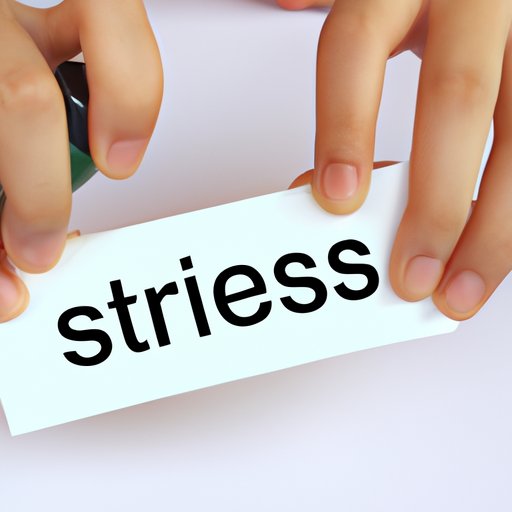
Introduction
Stress has become a prevalent health concern in modern life, and one of the most visible ways stress manifests in individuals is through the skin. Stress rash, also known as stress hives or stress urticaria, is a type of rash that appears on the skin as an itchy, swollen, sometimes red patch. The physical and mental symptoms of stress can be overwhelming, and dealing with visible physical symptoms like stress rash makes coping with stress even more difficult. This article aims to provide readers with a comprehensive understanding of stress rash, its causes, symptoms, prevention and treatment options, and coping strategies to foster positive physical and mental health.
Definition and Causes of Stress Rash
Stress rash is a skin condition that manifests as an itchy, red, or swollen rash in response to stress. It is caused by physical or emotional stress that triggers a stress response in the body. The stress response causes the release of hormones like cortisol and histamine, which in turn activate the immune system and cause inflammation. Stress rash typically appears on the chest, arms, or legs, but it can also appear on the face, neck, or torso.
Apart from stress, other causes of stress rash include anxiety, exposure to extreme temperatures, tight clothing, exercise, alcohol consumption, and a poor diet. Genetics also play a role, as some individuals may be more prone to developing stress rash as a result of their family history. Lifestyle choices such as smoking and exposure to pollution may also contribute to stress rash.
Prevention and Treatment of Stress Rash
Preventing stress rash begins with managing stress properly. Regular exercise, deep breathing exercises, meditation, or mindfulness practices can help reduce stress levels. Changes in lifestyle factors like avoiding tight clothing or extreme temperatures can also prevent stress rash. Moreover, some topical creams, such as aloe vera or calamine lotion, can soothe and relieve itching and inflammation caused by stress rash.
In terms of medical treatment, antihistamines like Benadryl or Zyrtec can reduce inflammation and relieve itching. Topical steroids or corticosteroids can help reduce inflammation and redness. Prescription antihistamines are available for severe cases of stress rash.
If the rash persists or the itching and swelling worsen despite self-care measures, medical intervention may be necessary and consultation with a dermatologist can be sought.
Recognizing Stress Rash in Different Forms
Stress rash can manifest differently in various parts of the body. For example, hives appear as raised, red, or white bumps that often appear suddenly and disappear quickly. Eczema, on the other hand, is a chronic skin condition that appears as dry, scaly patches that are itchy and can become inflamed. Redness, itching, and welts may also be indicators of stress rash.
To identify stress rash, it is important to pay attention to the location, appearance, and duration of the rash. Stress rash usually appears as a sudden onset of hives or welts that develop rapidly and disappear within hours or days. It is also common for stress rash to occur on the chest, arms, or legs, and is less likely to appear on the hands or feet.
Stress Rash vs. Other Rashes
It can be challenging to differentiate between stress rash and other types of rashes like hives, psoriasis, eczema, or contact dermatitis. Some symptoms, such as redness, itching or swelling, are common to many types of rashes. However, differentiating between rashes is critical to ensure proper treatment.
Stress rash differs from other rashes in that it usually occurs in response to a stressor and develops suddenly. Hives, on the other hand, can develop based on an allergic reaction to a food, medication, or insect bite. Psoriasis and eczema are chronic conditions, and while they can be triggered by stress, they also have distinct symptoms like scales or blisters that are not present in stress rash. Contact dermatitis requires exposure to an irritant and often occurs in a distinct pattern, such as the shape of the object that caused it. Consulting a medical professional can help accurately diagnose the condition.
Coping with Stress Rash in Daily Life
Coping with stress can be challenging, and it is essential to adopt self-care habits to prevent stress rash from worsening. Avoiding triggers and calming the stress response can help manage the rash in the short term. Wearing loose-fitting clothing and avoiding exposure to irritants and pollutants can help prevent stress rash in the long term. Moreover, topical or oral medication can help alleviate symptoms and promote healing. Managing stress through stress-reducing techniques and healthy lifestyle choices can prevent stress rash from developing or recurring.
Conclusion
Stress rash is a common and visible symptom of the impact of stress on physical and mental health. Identifying its symptoms, managing stress, and seeking medical treatment when necessary is necessary to prevent long-term damage to the skin and overall well-being. By adopting a healthy lifestyle and applying self-care techniques to cope with stress, individuals can prevent and manage stress rash and promote positive physical and mental health.





